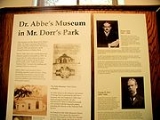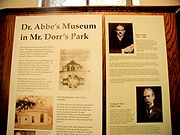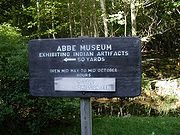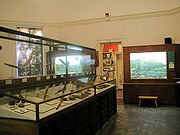
Robert Abbe
Encyclopedia
Robert Abbe was an American
surgeon
and pioneer radiologist
in New York City
. He was born in New York City and educated at the College of the City of New York
(S.B., 1871) and Columbia University
(M.D., 1874).
Abbe was most known as a plastic surgeon
, and between 1877 and 1884 he served as a surgeon and professor of surgery at the New York Hospital
, St. Luke's Hospital
, and the New York Babies Hospital. During this time, he would spend summers travelling, and he amassed a large collection of Native American
artifacts
and archeological materials.
He died of anemia
, possibly due to his work handling
radium
.


He befriended the Curies, and in particular Marie Curie. He collected many photographs of her, documented the production of radium
, and explored, with her, the medical uses of radiation and x-ray
s. In 1904, he introduced the practice of using radiation to treat cancer and founded the science of radiation oncology. In 1927, he founded the Abbe Museum of Native American artifacts.
In 1904, after corresponding with Professor and Madame Curie, he visited their laboratories in Paris. Joining in their groundbreaking research, he became the founder of radiation therapy in the United States. He was a vigorous opponent of the use of tobacco
which he considered a cause of cancer and reported over 100 cases of smoker's cancer. In later years, at his Bar Harbor summer home, "Brook End," Abbe created a garden in whose pool floated two swans – Pierre and Marie.
While summering in Bar Harbor, Abbe was fascinated by the ancient Native American tools found in nearby shell heaps. As he began collecting these artifacts, he realized the need for safe permanent storage. Even during a long illness, probably a result of his exposure to radium, he labored to establish the museum.
His dreams of a museum became reality with the help of friends such as George Dorr and Charles Eliot, the founding fathers of Acadia National Park. The dedication of the museum on August 14, 1928 was also a memorial to Robert Abbe. He had died just five months before.
Abbe amassed a sizeable collection of Native American archaeological material during his summers on Mount Desert Island. Opened in 1928, the Abbe was one of the first museums built in Maine. Its founding coincided with that of the national park, which was established as Lafayette National Park in 1919 and became Acadia in 1929. The Abbe was conceived as a trailside museum to complement the park’s offerings. Today it is one of only two remaining private trailside museums in national parks, the other one being the Borax Museum in Death Valley, California.
Robert Abbe was a man of many talents and interests. He was a photographer and an artist, painting, creating line drawings and molded maps. His large map "The Land of Dawn" is on display in the museum. The watercolor sketch on the right, of the museum, was completed by Abbe shortly before his death.

United States
The United States of America is a federal constitutional republic comprising fifty states and a federal district...
surgeon
Surgery
Surgery is an ancient medical specialty that uses operative manual and instrumental techniques on a patient to investigate and/or treat a pathological condition such as disease or injury, or to help improve bodily function or appearance.An act of performing surgery may be called a surgical...
and pioneer radiologist
Radiology
Radiology is a medical specialty that employs the use of imaging to both diagnose and treat disease visualized within the human body. Radiologists use an array of imaging technologies to diagnose or treat diseases...
in New York City
New York City
New York is the most populous city in the United States and the center of the New York Metropolitan Area, one of the most populous metropolitan areas in the world. New York exerts a significant impact upon global commerce, finance, media, art, fashion, research, technology, education, and...
. He was born in New York City and educated at the College of the City of New York
City College of New York
The City College of the City University of New York is a senior college of the City University of New York , in New York City. It is also the oldest of the City University's twenty-three institutions of higher learning...
(S.B., 1871) and Columbia University
Columbia University
Columbia University in the City of New York is a private, Ivy League university in Manhattan, New York City. Columbia is the oldest institution of higher learning in the state of New York, the fifth oldest in the United States, and one of the country's nine Colonial Colleges founded before the...
(M.D., 1874).
Abbe was most known as a plastic surgeon
Plastic surgery
Plastic surgery is a medical specialty concerned with the correction or restoration of form and function. Though cosmetic or aesthetic surgery is the best-known kind of plastic surgery, most plastic surgery is not cosmetic: plastic surgery includes many types of reconstructive surgery, hand...
, and between 1877 and 1884 he served as a surgeon and professor of surgery at the New York Hospital
New York Hospital
New York Hospital or “Old New York Hospital” or “City Hospital” was the oldest hospital in New York City and the second oldest hospital in the United States.-Early History:...
, St. Luke's Hospital
St. Luke's Hospital
St. Luke's Hospital may refer to:in Greece* St. Luke's Hospital in Ireland* St. Luke's General Hospital, Kilkenny* St. Luke's Hospital, Rathgar, Dublinin Japan* St. Luke's International Hospitalin Malta* St. Luke's Hospital, Malta...
, and the New York Babies Hospital. During this time, he would spend summers travelling, and he amassed a large collection of Native American
Native Americans in the United States
Native Americans in the United States are the indigenous peoples in North America within the boundaries of the present-day continental United States, parts of Alaska, and the island state of Hawaii. They are composed of numerous, distinct tribes, states, and ethnic groups, many of which survive as...
artifacts
Artifact (archaeology)
An artifact or artefact is "something made or given shape by man, such as a tool or a work of art, esp an object of archaeological interest"...
and archeological materials.
He died of anemia
Anemia
Anemia is a decrease in number of red blood cells or less than the normal quantity of hemoglobin in the blood. However, it can include decreased oxygen-binding ability of each hemoglobin molecule due to deformity or lack in numerical development as in some other types of hemoglobin...
, possibly due to his work handling
Radiation poisoning
Acute radiation syndrome also known as radiation poisoning, radiation sickness or radiation toxicity, is a constellation of health effects which occur within several months of exposure to high amounts of ionizing radiation...
radium
Radium
Radium is a chemical element with atomic number 88, represented by the symbol Ra. Radium is an almost pure-white alkaline earth metal, but it readily oxidizes on exposure to air, becoming black in color. All isotopes of radium are highly radioactive, with the most stable isotope being radium-226,...
.


Radiologist
Abbe was a renowned surgeon and medical pioneer. He was an attending surgeon at St. Luke's Hospital in New York, where the plastic surgical laboratory is named for him. He was a lecturer and fellow of the College of Physicians of Philadelphia and Vice President of the Academy of Medicine.He befriended the Curies, and in particular Marie Curie. He collected many photographs of her, documented the production of radium
Radium
Radium is a chemical element with atomic number 88, represented by the symbol Ra. Radium is an almost pure-white alkaline earth metal, but it readily oxidizes on exposure to air, becoming black in color. All isotopes of radium are highly radioactive, with the most stable isotope being radium-226,...
, and explored, with her, the medical uses of radiation and x-ray
X-ray
X-radiation is a form of electromagnetic radiation. X-rays have a wavelength in the range of 0.01 to 10 nanometers, corresponding to frequencies in the range 30 petahertz to 30 exahertz and energies in the range 120 eV to 120 keV. They are shorter in wavelength than UV rays and longer than gamma...
s. In 1904, he introduced the practice of using radiation to treat cancer and founded the science of radiation oncology. In 1927, he founded the Abbe Museum of Native American artifacts.
In 1904, after corresponding with Professor and Madame Curie, he visited their laboratories in Paris. Joining in their groundbreaking research, he became the founder of radiation therapy in the United States. He was a vigorous opponent of the use of tobacco
Tobacco smoking
Tobacco smoking is the practice where tobacco is burned and the resulting smoke is inhaled. The practice may have begun as early as 5000–3000 BCE. Tobacco was introduced to Eurasia in the late 16th century where it followed common trade routes...
which he considered a cause of cancer and reported over 100 cases of smoker's cancer. In later years, at his Bar Harbor summer home, "Brook End," Abbe created a garden in whose pool floated two swans – Pierre and Marie.
Museum
Abbe has been called "the best-loved summer resident of Bar Harbor." Those who knew him recognized his unique spirit, and many who visit the Museum today feel the specialness of the man and the museum.While summering in Bar Harbor, Abbe was fascinated by the ancient Native American tools found in nearby shell heaps. As he began collecting these artifacts, he realized the need for safe permanent storage. Even during a long illness, probably a result of his exposure to radium, he labored to establish the museum.
His dreams of a museum became reality with the help of friends such as George Dorr and Charles Eliot, the founding fathers of Acadia National Park. The dedication of the museum on August 14, 1928 was also a memorial to Robert Abbe. He had died just five months before.
Abbe amassed a sizeable collection of Native American archaeological material during his summers on Mount Desert Island. Opened in 1928, the Abbe was one of the first museums built in Maine. Its founding coincided with that of the national park, which was established as Lafayette National Park in 1919 and became Acadia in 1929. The Abbe was conceived as a trailside museum to complement the park’s offerings. Today it is one of only two remaining private trailside museums in national parks, the other one being the Borax Museum in Death Valley, California.
Robert Abbe was a man of many talents and interests. He was a photographer and an artist, painting, creating line drawings and molded maps. His large map "The Land of Dawn" is on display in the museum. The watercolor sketch on the right, of the museum, was completed by Abbe shortly before his death.


